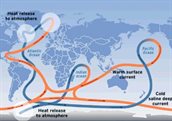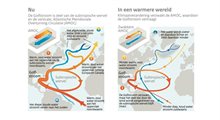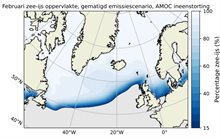What does climate change mean for the Gulf Stream?
In recent years, there has been growing attention to the possible effects of climate change on the Gulf Stream. This is the warm ocean current that carries tropical water northward, making Europe’s climate much milder than it would otherwise be. The Gulf Stream is part of a larger system of ocean currents called the AMOC – the Atlantic Meridional Overturning Circulation. Researchers warn that the AMOC could become much weaker, or even largely shut down, due to climate change. This could already happen later this century. What exactly is the AMOC? What do we already know? And what would happen if it stopped? Below you will find the key questions and answers.
What is the AMOC?
The AMOC is a huge system of ocean currents. In the Atlantic Ocean, it transports warm, salty surface water from the tropics to the north. Near Greenland, the water cools so much in winter that it becomes heavy and sinks, because salty water is heavier than fresh water. This very cold, salty water then flows southward through the deep ocean, carrying cold with it. Because water moves northward at the surface and back southward at depth, the AMOC is often called a giant “conveyor belt.” It keeps Europe’s climate relatively mild and affects weather all over the world.

Is the AMOC the same as the Gulf Stream?
Not exactly. The Gulf Stream is one part of the AMOC – the flow of warm surface water from the tropics to Europe. The AMOC also includes the return flow of cold, heavy water moving south through the deep ocean.
Is climate change making the AMOC weaker?
Scientists debate whether the AMOC has already weakened by 10–15% in recent decades. But they do agree that climate change will weaken it in the future. This is because Greenland’s ice sheet is melting and rainfall in the northern Atlantic is increasing. Both add fresh water to the ocean, making the water less salty. Fresher water is lighter, so it sinks less easily. This weakens the conveyor belt.

Could the AMOC shut down completely?
The Royal Netherlands Meteorological Institute (KNMI) states that the AMOC has a tipping point: if a critical limit is crossed, the system of currents could collapse. This process would take decades and could not be reversed. Scientists are studying whether this could happen this century. Recent research shows the AMOC may be more vulnerable than once thought. Even if the world follows the Paris Agreement, there could still be a 25% chance of collapse before 2100. The risk rises with higher greenhouse gas emissions. One study even suggests a shutdown as early as 2060. Some parts of the system are driven by wind and may continue, but even then the heat transport would be so weak that it would still count as a collapse.

What would happen if the AMOC shut down?
The impacts would be huge. Cold water would remain in the north instead of sinking southward. The extra cold would cause more sea ice to form, and sea ice reflects sunlight. That means the ocean would take up less heat, and cooling would increase further. While most of the world keeps warming, northwestern Europe would get colder. Key effects include:
- Winters in northwestern Europe (including the Netherlands) would be much colder: on average 3°C below pre-industrial levels. Cold extremes could be up to 15°C colder than today.
- More sea ice would disrupt marine life, fisheries, and shipping.
- Larger temperature differences between north and south Europe would mean stronger winter storms.
- Summers would become hotter and drier.
- Sea level rise along the Atlantic coasts would accelerate. Along the Dutch coast, levels could rise at least half a meter more on top of current projections.
- According to a British study, agricultural yields could decrease by up to 30 percent.
Can you see what the effects might be?
Based on 2025 research by Dutch scientists René van Westen and Michiel Baatsen, an online tool has been developed. This English-language tool includes a map that shows the global effects of changes in the AMOC under different scenarios. You can explore the tool at www.amocscenarios.org.
How certain is all this?
There is still a lot of uncertainty. Different climate models give different results. We don’t know for sure if or when the AMOC will shut down, or exactly what the impacts will be. The AMOC is a very complex system and more research is needed. Much also depends on how much greenhouse gas humans continue to emit. The more emissions, the higher the risk that the AMOC will weaken.